Polypyrrole–Nickel Hydroxide Hybrid Nanowires as Future Materials for Energy Storage
Abstract
1. Introduction
2. Materials and Methods
2.1. Fabrication of AAO Templates
2.2. Preparation of PPy-Ni(OH)2 Nanowire Array Electrodes
2.3. Samples Characterization
2.4. Study of Electrochemical Properties of PPy-Ni(OH)2 Electrodes
3. Results and Discussion
4. Conclusions
Author Contributions
Funding
Conflicts of Interest
References
- Gogotsi, Y.; Penner, R.M. Energy storage in nanomaterials—Capacitive pseudocapacitive, or battery-like? ACS Nano 2018, 12, 2081–2083. [Google Scholar] [CrossRef] [PubMed]
- Gogotsi, Y. What nano can do for energy storage. ACS Nano 2014, 8, 5369–5371. [Google Scholar] [CrossRef] [PubMed]
- Kagan, C.R.; Fernandez, L.E.; Gogotsi, Y.; Hammond, P.T.; Hersam, M.C.; Nel, A.E.; Penner, R.M.; Willson, C.G.; Weiss, P.S. Nano day: Celebrating the next decade of nanoscience and nanotechnology. ACS Nano 2016, 10, 9093–9103. [Google Scholar] [CrossRef] [PubMed]
- Kötz, R.; Carlen, M. Principles and applications of electrochemical capacitors. Electrochim. Acta 2000, 45, 2483–2498. [Google Scholar] [CrossRef]
- Burke, A. Ultracapacitors: Why, how, and where is the technology. J. Power Sources 2000, 91, 37–50. [Google Scholar] [CrossRef]
- Burke, A. R&D considerations for the performance and application of electrochemical capacitors. Electrochim. Acta 2007, 53, 1083–1091. [Google Scholar]
- Miller, J.R.; Burke, A.F. Electrochemical capacitors: Challenges and opportunities for real-world applications. Electrochem. Soc. Interface 2008, 17, 53–57. [Google Scholar]
- Fic, K.; Platek, A.; Piwek, J.; Frackowiak, E. Sustainable materials for electrochemical capacitors. Mater. Today 2018, 21, 437–454. [Google Scholar] [CrossRef]
- Gonzalez, A.; Goikolea, E.; Barrena, J.A.; Mysyk, R. Review on supercapacitors: Technologies and materials. Renew. Sust. Energy Rev. 2016, 58, 1189–1206. [Google Scholar] [CrossRef]
- Brousse, T.; Belanger, D.; Long, J.W. To be or not to be pseudocapacitive? J. Electrochem. Soc. 2015, 162, A5185–A5189. [Google Scholar] [CrossRef]
- Simon, P.; Gogotsi, Y.; Dunn, B. Where do batteries end and supercapacitors begin? Science 2014, 343, 1210–1211. [Google Scholar] [CrossRef] [PubMed]
- Laheäär, A.; Przygocki, P.; Abbas, Q.; Béguin, F. Appropriate methods for evaluating the efficiency and capacitive behavior of different types of supercapacitors. Electrochem. Commun. 2015, 60, 21–25. [Google Scholar] [CrossRef]
- Ho, M.Y.; Khiew, P.S.; Isa, D.; Tan, T.K.; Chiu, W.S.; Chia, C.H. A review of metal oxide composite electrode materials for electrochemical capacitors. Nano 2014, 9, 1430002. [Google Scholar] [CrossRef]
- Jang, J. Conducting polymer nanomaterials and their applications. Adv. Polym. Sci. 2006, 199, 189–259. [Google Scholar]
- Snook, G.A.; Kao, P.; Best, A.S. Conducting-polymer-based supercapacitor devices and electrodes. J. Power Sources 2011, 196, 1–12. [Google Scholar] [CrossRef]
- Xu, C.; Yan, J.; Qin, Q.; Deng, Y.; Cheng, J.; Zhang, Y.; Wu, Y. All solid supercapacitors based on an anion conducting polymer electrolyte. RSC Adv. 2016, 6, 19826–19832. [Google Scholar] [CrossRef]
- Gence, L.; Faniel, S.; Gustin, C.; Melinte, S.; Bayot, V.; Callegari, V.; Reynes, O.; Demoustier-Champagne, S. Structural and electrical characterization of hybrid metal-polypyrrole nanowires. Phys. Rev. B 2007, 76, 115415. [Google Scholar] [CrossRef]
- Jing, S.Y.; Xing, S.X.; Yu, L.X.; Wu, Y.; Zhao, C. Synthesis and characterization of Ag/polyaniline core-shell nanocomposites based on silver nanoparticles colloid. Mater. Lett. 2007, 61, 2794–2797. [Google Scholar] [CrossRef]
- Bryaskova, R.; Pencheva, D.; Kale, G.M.; Lad, U.; Kantardjiev, T. Synthesis, characterisation and antibacterial activity of PVA/TEOS/Ag-Np hybrid thin films. J. Colloid Interface Sci. 2010, 349, 77–85. [Google Scholar] [CrossRef] [PubMed]
- Dar, F.I.; Moonooswamy, K.R.; Es-Souni, M. Morphology and property control of NiO nanostructures for supercapacitor applications. Nanoscale Res. Lett. 2013, 8, 363. [Google Scholar] [CrossRef] [PubMed]
- Zhao, B.; Wang, T.; Jiang, L.; Zhang, K.; Yuen, M.M.F.; Xu, J.B.; Fu, X.Z.; Sun, R.; Wong, C.P. NiO mesoporous nanowalls grown on RGO coated nickel foam as high performance electrodes for supercapacitors and biosensors. Electrochim. Acta 2016, 192, 205–215. [Google Scholar] [CrossRef]
- Anjali, P.; Sonia, T.S.; Shakir, I.; Nair, S.V.; Balakrishnan, A. On the synthesis and electrochemical characterization of ordered hierarchical NiO micro bouquets with trimodal pore size distribution. J. Alloy. Compd. 2015, 618, 396–402. [Google Scholar] [CrossRef]
- Huang, M.L.; Gu, C.D.; Ge, X.; Wang, X.L.; Tu, J.P. NiO nanoflakes grown on porous graphene frameworks as advanced electrochemical pseudocapacitor materials. J. Power Sources 2014, 259, 98–105. [Google Scholar] [CrossRef]
- Ren, Y.R.; Wei, H.M.; Huang, X.B.; Yang, B.; Wang, J.W.; Ding, J.N. Fabrication of NiO nanowires/G composite as electrode material for high performance supercapacitor. Int. J. Electrochem. Sci. 2014, 9, 7206–7216. [Google Scholar]
- Terasawa, N.; Asaka, K. High-performance hybrid (electrostatic double-layer and faradaic capacitor-based) polymer actuators incorporating nickel oxide and vapor-grown carbon nanofibers. Langmuir 2014, 30, 14343–14351. [Google Scholar] [CrossRef] [PubMed]
- Chang, J.H.; Park, M.; Ham, D.; Ogale, S.B.; Mane, R.S.; Han, S.H. Liquid-phase synthesized mesoporous electrochemical supercapacitors of nickel hydroxide. Electrochim. Acta 2008, 53, 5016–5021. [Google Scholar] [CrossRef]
- Singu, B.S.; Male, U.; Hong, S.E.; Yoon, K.R. Synthesis and performance of nickel hydroxide nanodiscs for redox supercapacitors. Ionics 2016, 22, 1485–1491. [Google Scholar] [CrossRef]
- Wu, M.S.; Wu, J.F. Nickel hydroxide electrode with porous nanotube arrays prepared by hydrolysis and cathodic deposition for high-performance supercapacitors. J. Power Sources 2013, 240, 397–403. [Google Scholar] [CrossRef]
- Yuksel, R.; Coskun, S.; Kalay, Y.E.; Unalan, H.E. Flexible, silver nanowire network nickel hydroxide core-shell electrodes for supercapacitors. J. Power Sources 2016, 328, 167–173. [Google Scholar] [CrossRef]
- Jiang, H.; Zhao, T.; Li, Ch.; Ma, J. Hierarchical self-assembly of ultrathin nickel hydroxide nanoflakes for high-performance supercapacitors. J. Mater. Chem. 2011, 21, 3818–3823. [Google Scholar] [CrossRef]
- Aghazadeh, M.; Ghaemi, M.; Sabour, B.; Dalvand, S. Electrochemical preparation of α-Ni(OH)2 ultrafine nanoparticles for high-performance supercapacitors. J. Solid State Electr. 2014, 18, 1569–1584. [Google Scholar] [CrossRef]
- Hall, D.S.; Lockwood, D.J.; Bock, C.; MacDougall, B.R. Nickel hydroxides and related materials: A review of their structures, synthesis and properties. Proc. R. Soc. A 2015, 471, 20140792. [Google Scholar] [CrossRef] [PubMed]
- Huang, J.; Lei, T.; Wei, X.; Liu, X.; Liu, T.; Cao, D.; Yin, J.; Wang, G. Effect of Al-doped β-Ni(OH)2 nanosheets on electrochemical behaviors for high performance supercapacitor application. J. Power Sources 2013, 232, 370–375. [Google Scholar] [CrossRef]
- Wang, Y.; Zhang, X.; Li, X.; Li, X.; Zhao, Y.; Wei, H.; Liu, Y.; Jiang, P.; Liang, M. Highly dispersed ultrasmall Ni(OH)2 aggregated particles on a conductive support as a supercapacitor electrode with superior performance. J. Colloid Interf. Sci 2017, 490, 252–258. [Google Scholar] [CrossRef] [PubMed]
- Li, L.; Xu, J.; Lei, J.; Zhang, J.; McLarnon, F.; Wei, Z.; Li, N.; Pan, F. A one-step, cost-effective green method to in situ fabricate Ni(OH)2 hexagonal platelets on Ni foam as binder-free supercapacitor electrode materials. J. Mater. Chem. A 2015, 3, 1953–1960. [Google Scholar] [CrossRef]
- Sun, W.; Rui, X.; Ulaganathan, M.; Madhavi, S.; Yan, Q. Few-layered Ni(OH)2 nanosheets for high-performance supercapacitors. J. Power Sources 2015, 295, 323–328. [Google Scholar] [CrossRef]
- Xiong, X.-B.; Zhang, J.-Y.; Ma, J.; Zeng, X.-R.; Qian, H.; Li, Y.-Y. Fabrication of porous nickel (hydr)oxide film with rational pore size distribution on nickel foam by induction heating deposition for high-performance supercapacitors. Mater. Chem. Phys. 2016, 181, 1–6. [Google Scholar] [CrossRef]
- Palani, N.S.; Kavitha, N.S.; Venkatesh, K.S.; Ashok Kumar, K.; Thirumal, V.; Pandurangan, A.; Sekar, S.; Ilangovan, R. Effect of NiO/Ni(OH)2 nanostructures in graphene/CNT nanocomposites on their interfacial charge transport kinetics for high-performance supercapacitors. J. Solid State Electrochem. 2018, 22, 3273–3287. [Google Scholar] [CrossRef]
- Brisse, A.-L.; Stevens, P.; Toussaint, G.; Crosnier, O.; Brousse, T. Ni(OH)2 and NiO based composites: battery type electrode materials for hybrid supercapacitor devices. Materials 2018, 11, 1178. [Google Scholar] [CrossRef] [PubMed]
- Mahmood, N.; Zhang, C.Z.; Yin, H.; Hou, Y.L. Graphene-based nanocomposites for energy storage and conversion in lithium batteries, supercapacitors and fuel cells. J. Mater. Chem. A 2014, 2, 15–32. [Google Scholar] [CrossRef]
- Pal, K.; Panwar, V.; Bag, S.; Manuel, J.; Ahn, J.H.; Kim, J.K. Graphene oxide-polyaniline-polypyrrole nanocomposite for a supercapacitor electrode. RSC Adv. 2015, 5, 3005–3010. [Google Scholar] [CrossRef]
- Zhou, Y.; Xu, H.P.; Lachman, N.; Ghaffari, M.; Wu, S.; Liu, Y.; Ugur, A.; Gleason, K.K.; Wardle, B.L.; Zhang, Q.M. Advanced asymmetric supercapacitor based on conducting polymer and aligned carbon nanotubes with controlled nanomorphology. Nano Energy 2014, 9, 176–185. [Google Scholar] [CrossRef]
- Zhou, H.B.; Han, G.Y.; Chang, Y.Z.; Fu, D.Y.; Xiao, Y.M. Highly stable multi-wall carbon nanotubes@poly(3,4-ethylenedioxythiophene)/poly(styrene sulfonate) core-shell composites with three-dimensional porous nano-network for electrochemical capacitors. J. Power Sources 2015, 274, 229–236. [Google Scholar] [CrossRef]
- Jin, Y.H.; Jia, M.Q. Design and synthesis of nanostructured graphene-SnO2-polyaniline ternary composite and their excellent supercapacitor performance. Colloid Surface A 2015, 464, 17–25. [Google Scholar] [CrossRef]
- Luo, Z.Y.; Zhu, Y.H.; Liu, E.H.; Hu, T.T.; Li, Z.P.; Liu, T.T.; Song, L.C. Synthesis of polyaniline/SnO2 nanocomposite and its improved electrochemical performance. Mater. Res. Bull. 2014, 60, 105–110. [Google Scholar] [CrossRef]
- Wang, W.J.; Lei, W.; Yao, T.Y.; Xia, X.F.; Huang, W.J.; Hao, Q.L.; Wang, X. One-pot synthesis of graphene/SnO2/PEDOT ternary electrode material for supercapacitors. Electrochim. Acta 2013, 108, 118–126. [Google Scholar] [CrossRef]
- Deshmukh, P.R.; Patil, S.V.; Bulakhe, R.N.; Sartale, S.D.; Lokhande, C.D. Inexpensive synthesis route of porous polyaniline-ruthenium oxide composite for supercapacitor application. Chem. Eng. J. 2014, 257, 82–89. [Google Scholar] [CrossRef]
- Lee, H.; Cho, M.S.; Kim, I.H.; Nam, J.D.; Lee, Y. RuOx/polypyrrole nanocomposite electrode for electrochemical capacitors. Synthetic Met. 2010, 160, 1055–1059. [Google Scholar] [CrossRef]
- Yan, Y.F.; Cheng, Q.L.; Pavlinek, V.; Saha, P.; Li, C.Z. Fabrication of polyaniline/mesoporous carbon/MnO2 ternary nanocomposites and their enhanced electrochemical performance for supercapacitors. Electrochim. Acta 2012, 71, 27–32. [Google Scholar] [CrossRef]
- Han, G.Q.; Liu, Y.; Zhang, L.L.; Kan, E.J.; Zhang, S.P.; Tang, J.; Tang, W.H. MnO2 nanorods intercalating graphene oxide/polyaniline ternary composites for robust high-performance supercapacitors. Sci. Rep. 2014, 4, 4824. [Google Scholar] [CrossRef] [PubMed]
- Zhang, J.; Liu, Y.; Guan, H.; Zhao, Y.; Zhang, B. Decoration of nickel hydroxide nanoparticles onto polypyrrole nanotubes with enhanced electrochemical performance for supercapacitors. J. Alloy. Compd. 2017, 721, 731–740. [Google Scholar] [CrossRef]
- Ginting, R.T.; Ovhal, M.M.; Kang, J.-W. A novel design of hybrid transparent electrodes for high performance and ultra-flexible bifunctional electrochromic-supercapacitors. Nano Energy 2018, 53, 650–657. [Google Scholar] [CrossRef]
- Scarabelot, L.; Muller, D.; De Souza, L.V.; Hotza, D.; Rambo, C.R. Ni(OH)2 aerogels incorporated with polypyrrole as electrodes for supercapacitors. J. Electron. Mater. 2017, 46, 5232–5239. [Google Scholar] [CrossRef]
- Das, A.K.; Maitra, A.; Karan, S.K.; Bera, R.; Paria, S.; Khatua, B.B. Polyaniline/α-Ni(OH)2/iron oxide-doped reduced graphene oxide-based hybrid electrode material. J. Appl. Electrochem. 2017, 47, 531–546. [Google Scholar] [CrossRef]
- Jiang, W.; Yu, D.; Zhang, Q.; Goh, K.; Wei, L.; Yong, Y.; Jiang, R.; Wei, J.; Chen, Y. Ternary hybrids of amorphous nickel hydroxide–carbon nanotube-conducting polymer for supercapacitors with high energy density, excellent rate capability, and long cycle life. Adv. Funct. Mater. 2015, 25, 1063–1073. [Google Scholar] [CrossRef]
- Yang, H.; Xu, H.; Li, M.; Zhang, L.; Huang, Y.; Hu, X. Assembly of NiO/Ni(OH)2/PEDOT nanocomposites on contra wires for fiber-shaped flexible asymmetric supercapacitors. ACS Appl. Mater. Inter. 2016, 8, 1774–1779. [Google Scholar] [CrossRef] [PubMed]
- Ma, L.; Su, L.; Zhang, J.; Zhao, D.; Qin, Ch.; Jin, Z.; Zhao, K. A controllable morphology GO/PANI/metal hydroxide composite for supercapacitor. J. Electroanal. Chem. 2016, 777, 75–84. [Google Scholar] [CrossRef]
- Sulka, G.D.; Brzozka, A.; Zaraska, L.; Jaskula, M. Through-hole membranes of nanoporous alumina formed by anodizing in oxalic acid and their applications in fabrication of nanowire arrays. Electrochim. Acta 2010, 55, 4368–4376. [Google Scholar] [CrossRef]
- Brudzisz, A.; Brzozka, A.; Sulka, G.D. Effect of processing parameters on pore opening and mechanism of voltage pulse detachment of nanoporous anodic alumina. Electrochim. Acta 2015, 178, 374–384. [Google Scholar] [CrossRef]
- El Meguid, E.A.A.; Oki, T. Corrosion behavior of various nickel layers electroplated from watts bath. Mater. T. JIM 1995, 36, 659–663. [Google Scholar] [CrossRef]
- Li, X.W.; Lei, Z.W.; Qu, J.; Hu, H.M.; Zhang, Q.W. Separation of copper from nickel in sulfate solutions by mechanochemical activation with CaCO3. Sep. Purif. Technol. 2017, 172, 107–112. [Google Scholar] [CrossRef]
- Sulka, G.D.; Hnida, K.; Brzozka, A. pH sensors based on polypyrrole nanowire arrays. Electrochim. Acta 2013, 104, 536–541. [Google Scholar] [CrossRef]
- Hnida, K.E.; Socha, R.P.; Sulka, G.D. Polypyrrole-silver composite nanowire arrays by cathodic co-deposition and their electrochemical properties. J. Phys. Chem. C 2013, 117, 19382–19392. [Google Scholar] [CrossRef]
- Moharana, M.; Mallik, A. Nickel electrocrystallization in different electrolytes: An in-process and post synthesis analysis. Electrochim. Acta 2013, 98, 1–10. [Google Scholar] [CrossRef]
- Malpass, G.R.P.; Kalaji, M.; Venancio, E.C.; Motheo, A.J. Electrodeposition of nickel on carbon felt. Electrochim. Acta 2004, 49, 4933–4938. [Google Scholar] [CrossRef]
- Ashassi-Sorkhabi, H.; Badakhshan, P.L.; Asghari, E. Electrodeposition of three dimensional-porous Ni/Ni(OH)2 hierarchical nano composite via etching the Ni/Zn/Ni(OH)2 precursor as a high performance pseudocapacitor. Chem. Eng. J. 2016, 299, 282–291. [Google Scholar] [CrossRef]
- Yang, G.W.; Xu, C.L.; Li, H.L. Electrodeposited nickel hydroxide on nickel foam with ultrahigh capacitance. Chem. Commun. 2008. [Google Scholar] [CrossRef] [PubMed]
- Wang, Y.M.; Zhao, D.D.; Zhao, Y.Q.; Xu, C.L.; Li, H.L. Effect of electrodeposition temperature on the electrochemical performance of a Ni(OH)2 electrode. RSC Adv. 2012, 2, 1074–1082. [Google Scholar] [CrossRef]
- Ma, W.L.; Wang, L.; Xue, J.Y.; Cui, H.T. A bottom-up strategy for exfoliation-free synthesis of soluble alpha-Ni(OH)2 monolayer nanosheets on a large scale. RSC Adv. 2016, 6, 85367–85373. [Google Scholar] [CrossRef]
- Biesinger, M.C.; Payne, B.P.; Grosvenor, A.P.; Lau, L.W.M.; Gerson, A.R.; Smart, R.S. Resolving surface chemical states in XPS analysis of first row transition metals, oxides and hydroxides: Cr, Mn, Fe, Co and Ni. Appl. Surf. Sci. 2011, 257, 2717–2730. [Google Scholar] [CrossRef]
- Biesinger, M.C.; Lau, L.W.M.; Gerson, A.R.; Smart, R.S.C. The role of the auger parameter in XPS studies of nickel metal, halides and oxides. Phys. Chem. Chem. Phys. 2012, 14, 2434–2442. [Google Scholar] [CrossRef] [PubMed]
- Algharaibeh, Z.; Pickup, P.G. An asymmetric supercapacitor with anthraquinone and dihydroxybenzene modified carbon fabric electrodes. Electrochem. Commun. 2011, 13, 147–149. [Google Scholar] [CrossRef]
- Roldán, S.; Blanco, C.; Granda, M.; Menéndez, R.; Santamaría, R. Towards a further generation of high-energy carbon-based capacitors by using redox-active electrolytes. Angew. Chem. Int. Edit. 2011, 50, 1699–1701. [Google Scholar] [CrossRef] [PubMed]
- Roldan, S.; Granda, M.; Menendez, R.; Santamaria, R.; Blanco, C. Mechanisms of energy storage in carbon-based supercapacitors modified with a quinoid redox-active electrolyte. J. Phys. Chem. C 2011, 115, 17606–17611. [Google Scholar] [CrossRef]
- Senthilkumar, S.T.; Selvan, R.K.; Ponpandian, N.; Melo, J.S. Redox additive aqueous polymer gel electrolyte for an electric double layer capacitor. RSC Adv. 2012, 2, 8937–8940. [Google Scholar] [CrossRef]
- Anjos, D.M.; McDonough, J.K.; Perre, E.; Brown, G.M.; Overbury, S.H.; Gogotsi, Y.; Presser, V. Pseudocapacitance and performance stability of quinone-coated carbon onions. Nano Energy 2013, 2, 702–712. [Google Scholar] [CrossRef]
- Boota, M.; Hatzell, K.B.; Kumbur, E.C.; Gogotsi, Y. Towards high-energy-density pseudocapacitive flowable electrodes by the incorporation of hydroquinone. ChemSusChem 2015, 8, 835–843. [Google Scholar] [CrossRef] [PubMed]
- Bora, C.; Sharma, J.; Dolui, S. Polypyrrole/sulfonated graphene composite as electrode material for supercapacitor. J. Phys. Chem. C 2014, 118, 29688–29694. [Google Scholar] [CrossRef]
- Chen, S.; Zhitomirsky, I. Polypyrrole electrodes doped with sulfanilic acid azochromotrop for electrochemical supercapacitors. J. Power Sources 2013, 243, 865–871. [Google Scholar] [CrossRef]
- Chen, W.; Xia, C.; Rakhi, R.B.; Alshareerf, H.N. A general approach toward enhancement of pseudocapacitive performance of conducting polymers by redox-active electrolytes. J. Power Sources 2014, 267, 521–526. [Google Scholar] [CrossRef]
- Fic, K.; Frackowiak, E.; Beguin, F. Unusual energy enhancement in carbon-based electrochemical capacitors. J. Mater. Chem. 2012, 22, 24213–24223. [Google Scholar] [CrossRef]

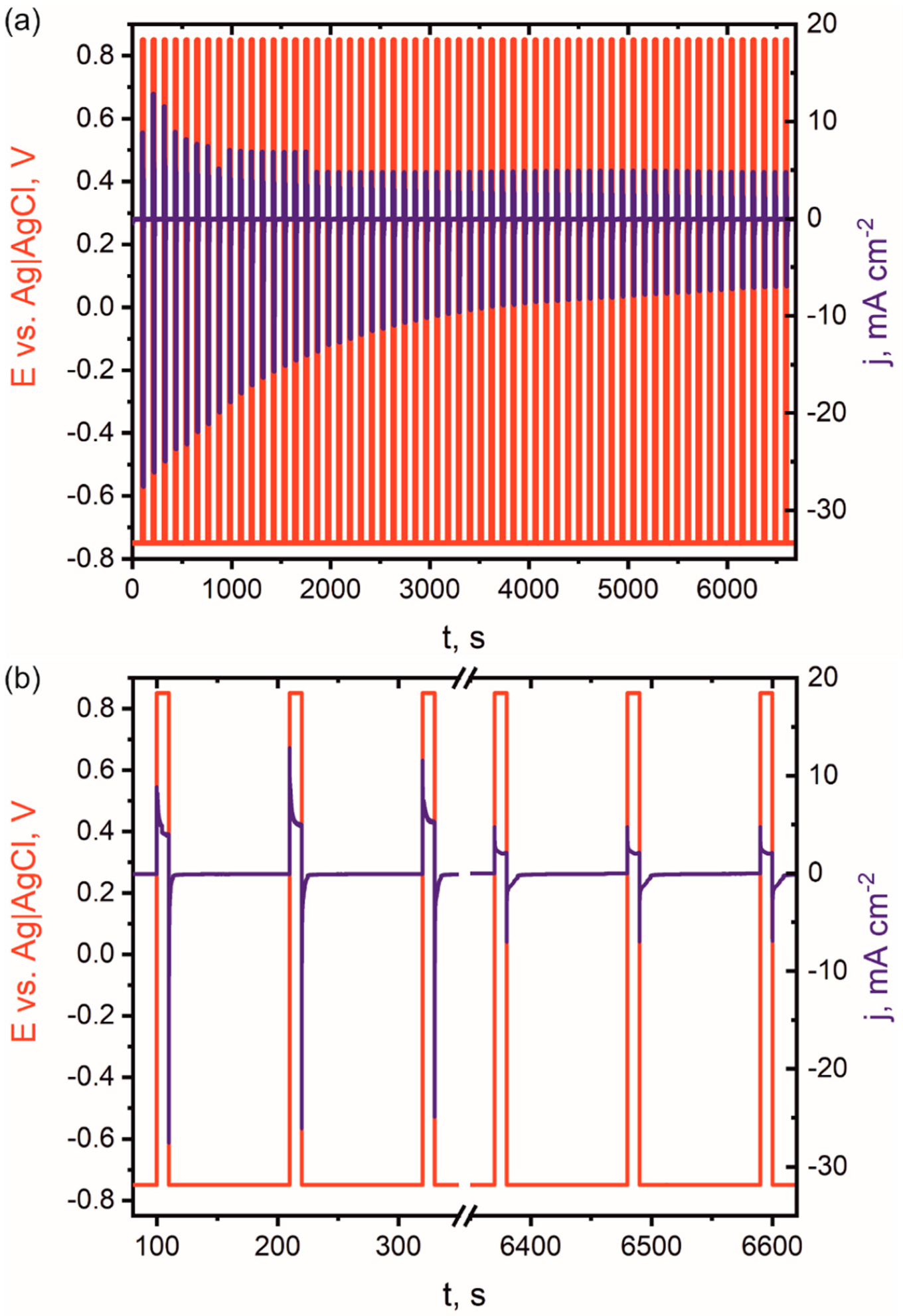
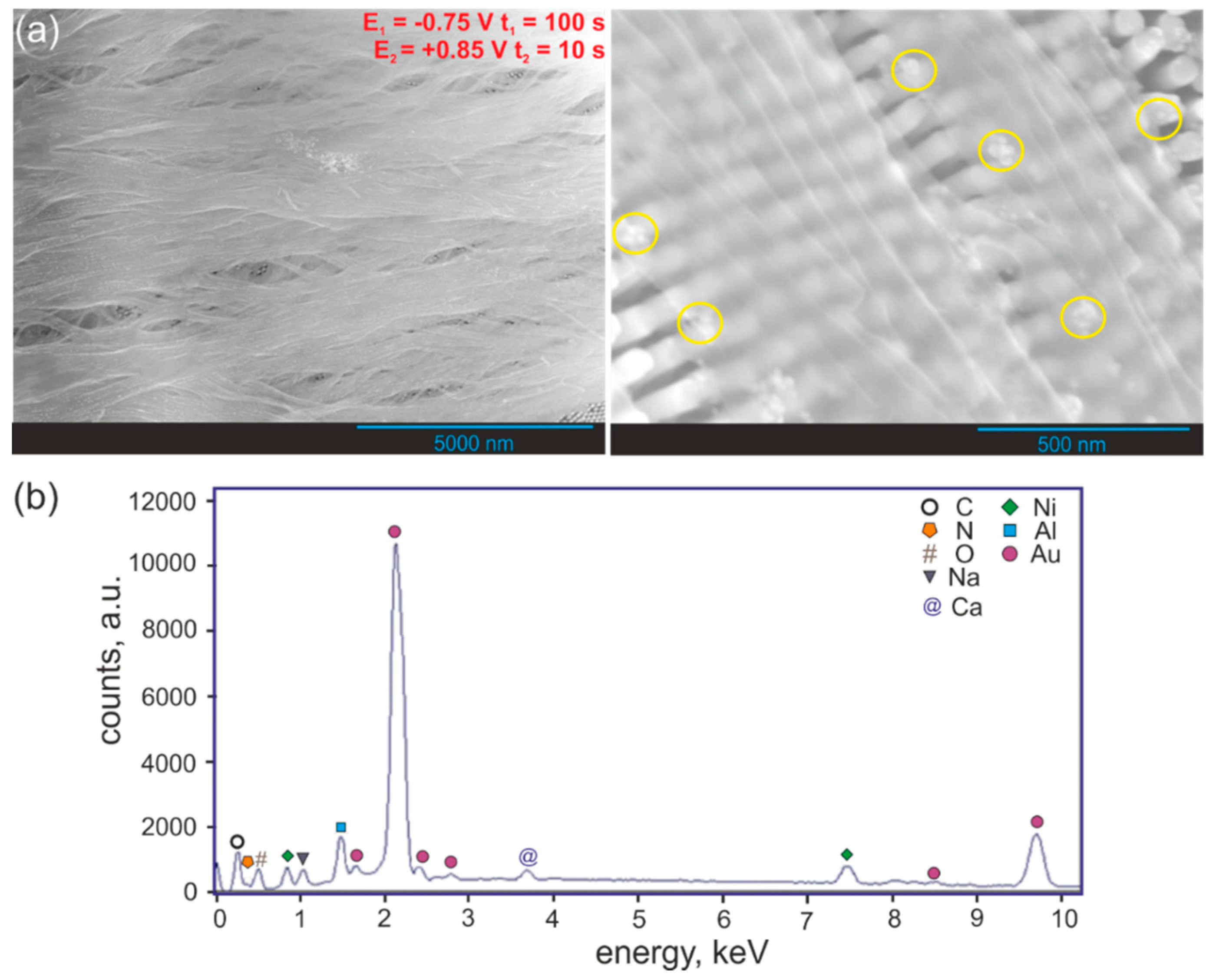
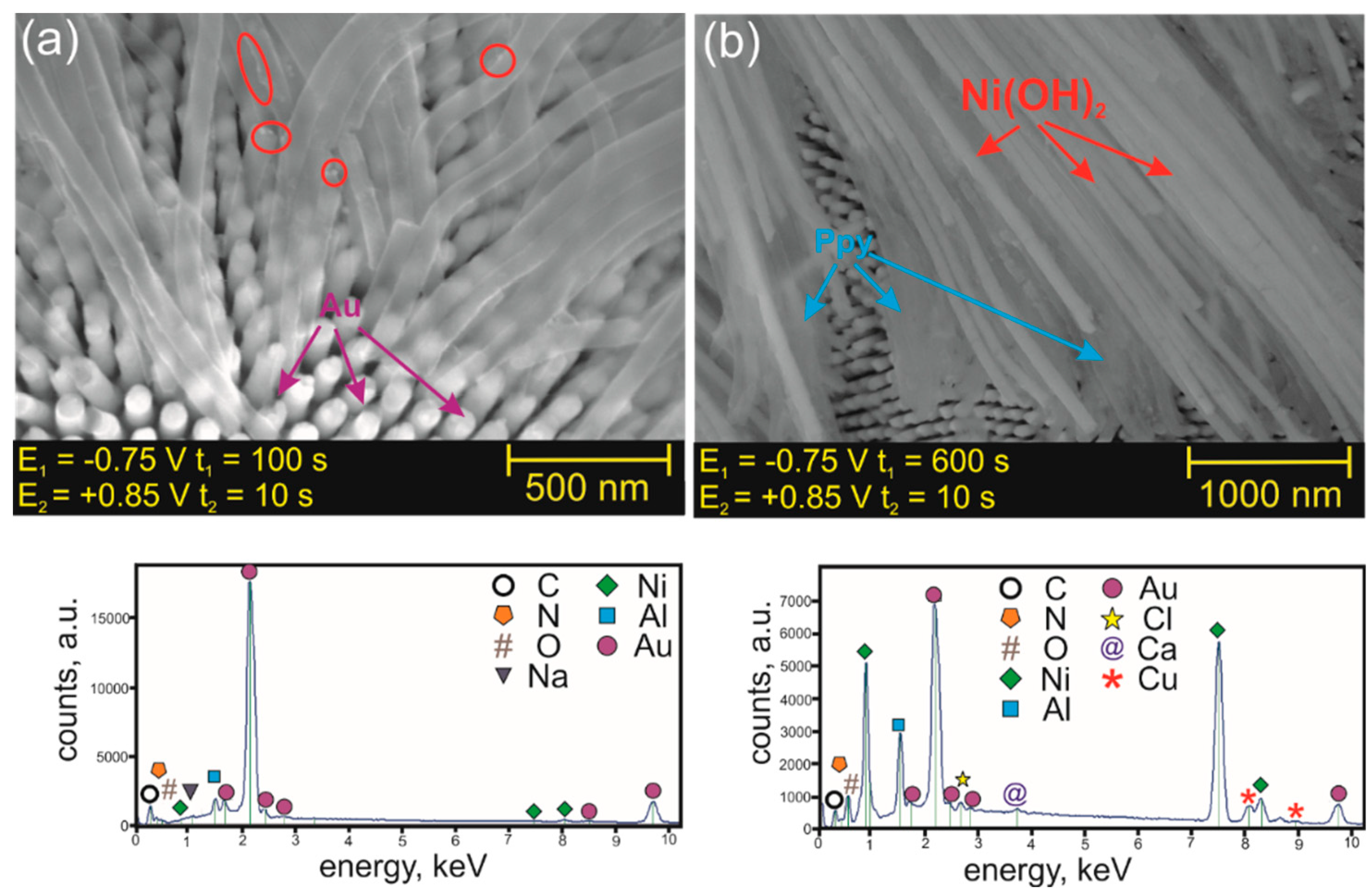
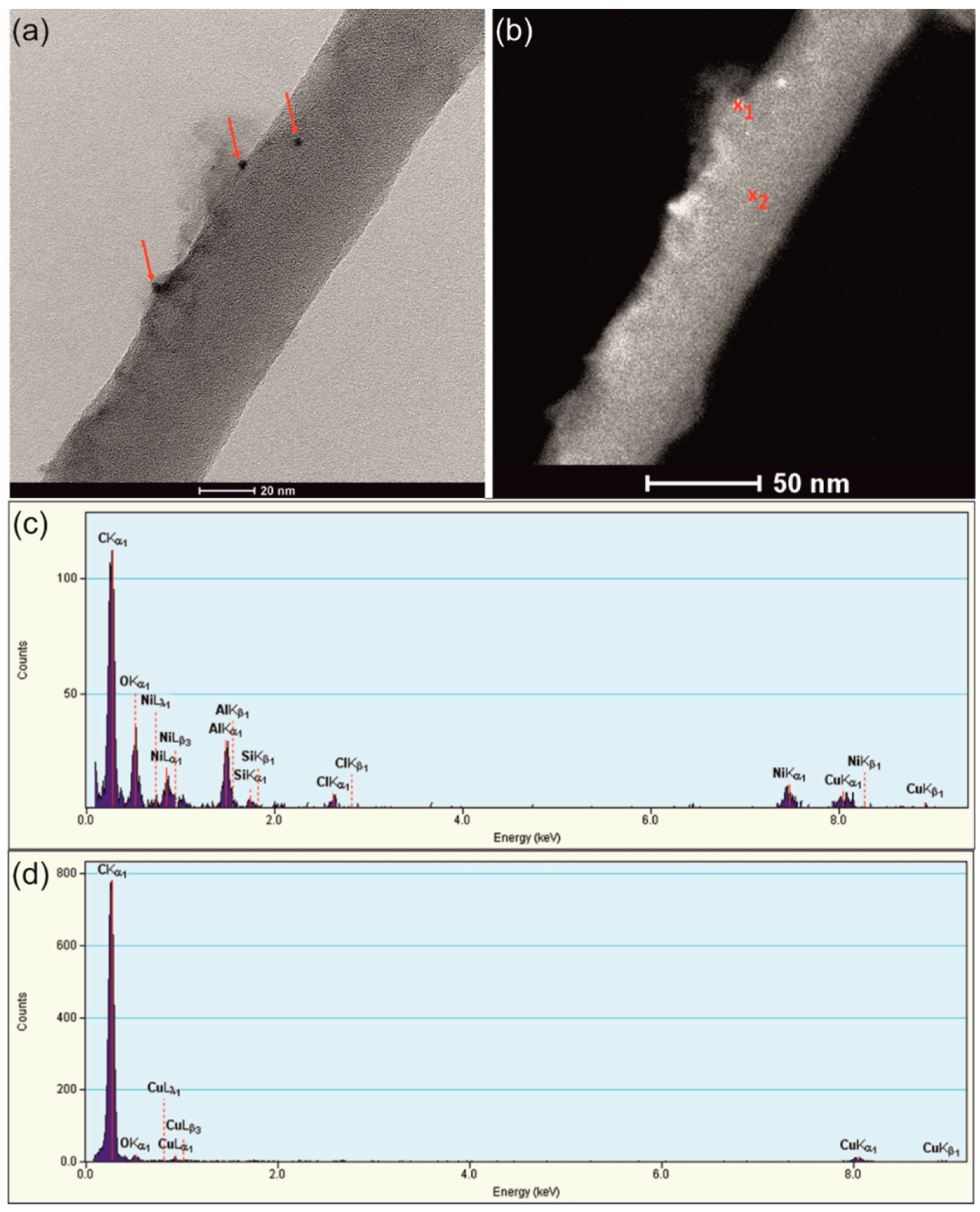
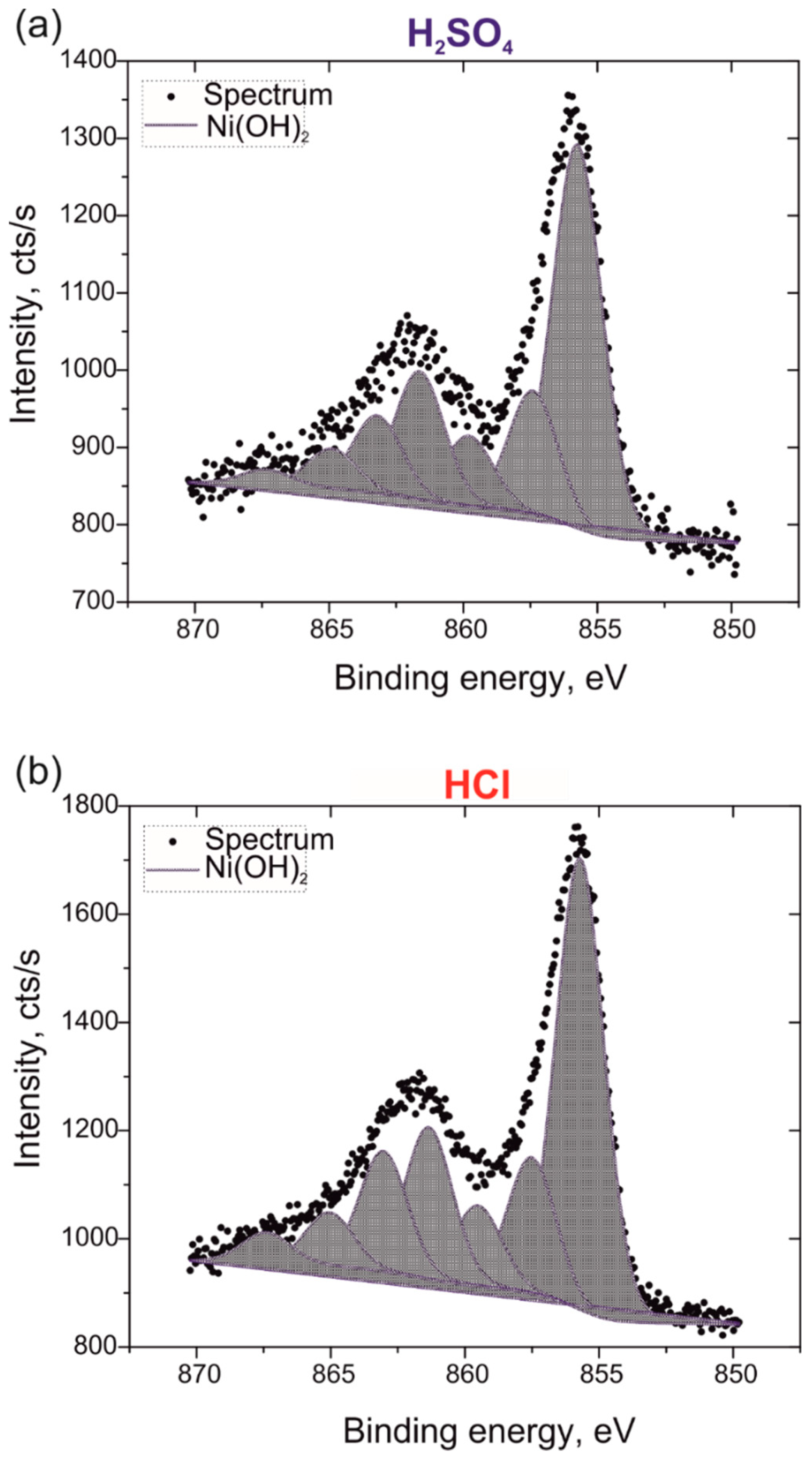
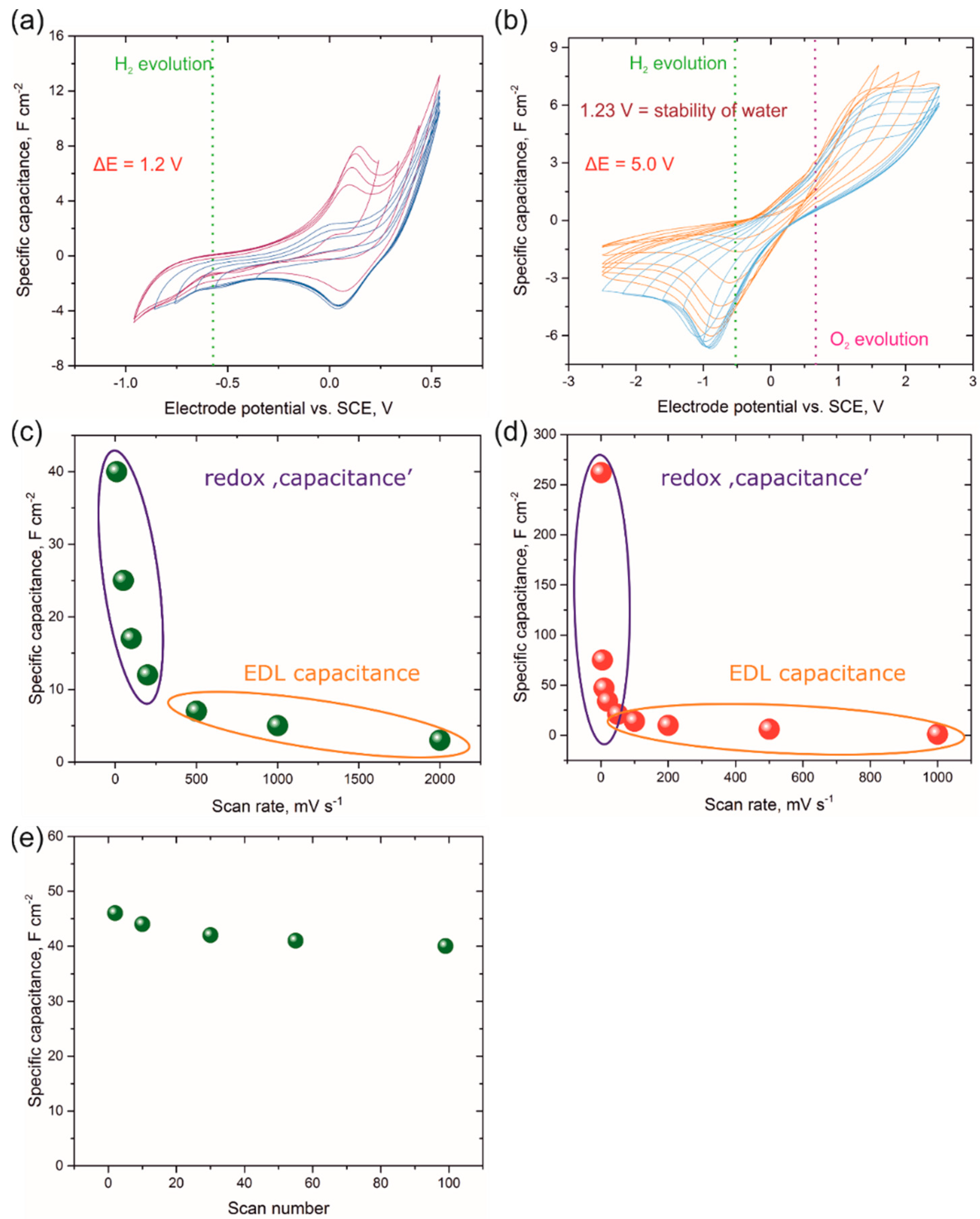
© 2019 by the authors. Licensee MDPI, Basel, Switzerland. This article is an open access article distributed under the terms and conditions of the Creative Commons Attribution (CC BY) license (http://creativecommons.org/licenses/by/4.0/).
Share and Cite
Brzózka, A.; Fic, K.; Bogusz, J.; Brudzisz, A.M.; Marzec, M.M.; Gajewska, M.; Sulka, G.D. Polypyrrole–Nickel Hydroxide Hybrid Nanowires as Future Materials for Energy Storage. Nanomaterials 2019, 9, 307. https://doi.org/10.3390/nano9020307
Brzózka A, Fic K, Bogusz J, Brudzisz AM, Marzec MM, Gajewska M, Sulka GD. Polypyrrole–Nickel Hydroxide Hybrid Nanowires as Future Materials for Energy Storage. Nanomaterials. 2019; 9(2):307. https://doi.org/10.3390/nano9020307
Chicago/Turabian StyleBrzózka, Agnieszka, Krzysztof Fic, Joanna Bogusz, Anna M. Brudzisz, Mateusz M. Marzec, Marta Gajewska, and Grzegorz D. Sulka. 2019. "Polypyrrole–Nickel Hydroxide Hybrid Nanowires as Future Materials for Energy Storage" Nanomaterials 9, no. 2: 307. https://doi.org/10.3390/nano9020307
APA StyleBrzózka, A., Fic, K., Bogusz, J., Brudzisz, A. M., Marzec, M. M., Gajewska, M., & Sulka, G. D. (2019). Polypyrrole–Nickel Hydroxide Hybrid Nanowires as Future Materials for Energy Storage. Nanomaterials, 9(2), 307. https://doi.org/10.3390/nano9020307





